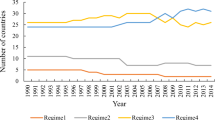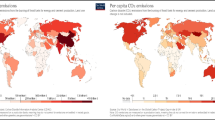Abstract
Vigorously developing high-tech industry has been considered to be an effective way to coordinate economic growth with excessive carbon dioxide (CO2) emissions. However, previous studies have not explored the heterogeneous impacts of high-tech industry on CO2 emissions in regions with different levels of high-tech industry development, and not distinguished the direct and indirect impacts. Based on STIRPAT model, this study investigates the impacts of high-tech industry development on CO2 emissions in China between 2005 and 2016. Adopting the K-medians cluster method, effects in regions with high, middle, and low levels of high-tech industry development are considered. Indirect effects of high-tech industry development on CO2 emissions by affecting industry structure upgrades and economic growth are explored. Empirical results illustrate a positive U-shaped nonlinear link between the level of high-tech industry development and CO2 emissions at the national level and regional (high, middle, and low) level. In terms of indirect impacts, high-tech industry development attenuates the reduction of CO2 emissions due to industry structure upgrades, and promotes economic growth to increase CO2 emissions slightly. The indirect impact intensity gradually decreases as the level of high-tech industry development decreases across three regions. Reasonable implications of our findings are proposed.



Similar content being viewed by others
Notes
Thirty provinces and cities referred to in this paper denote provinces and cities excluding Tibet, Hong Kong, Macao, and Taiwan in China.
References
Azomahou T, Laisney F, Van Nguyen P (2006) Economic development and CO2 emissions: a nonparametric panel approach. J Public Econ 90(6-7):1347–1363. https://doi.org/10.1016/j.jpubeco.2005.09.005
Balli HO, Sørensen BE (2012) Interaction effects in econometrics. Empir Econ 45(1):583–603. https://doi.org/10.1007/s00181-012-0604-2
Belaissaouia B, Le Moullecb Y, Favrea E (2016) Energy efficiency of a hybrid membrane/condensation process for VOC (volatile organic compounds) recovery from air: a generic approach. Energy. 95:291–302. https://doi.org/10.1016/j.energy.2015.12.006
Bhat JA, Haider S, Kamaiah B (2018) Interstate energy efficiency of Indian paper industry: A slack-based non-parametric approach. Energy 161:284–298. https://doi.org/10.1016/j.energy.2018.07.138
Carson RT (2009) The environmental Kuznets curve: seeking empirical regularity and theoretical structure. Rev Environ Econ Policy 4(1):3–23. https://doi.org/10.1093/reep/rep021
Chang N (2015) Changing industrial structure to reduce carbon dioxide emissions: a Chinese application. J Clean Prod 103:40–48. https://doi.org/10.1016/j.jclepro.2014.03.003
Chen Y, Lu H, Li J, Huang G, He L (2016) Regional planning of new-energy systems within multi-period and multi-option contexts: a case study of Fengtai, Beijing, China. Renew Sustain Energy Rev 65:356–372. https://doi.org/10.1016/j.rser.2016.07.017
Chen J, Wang S, Zhou C, Li M (2019) Does the path of technological progress matter in mitigating China’s PM2.5 concentrations? Evidence from three urban agglomerations in China. Environ Pollut 254(Pt A):113012. https://doi.org/10.1016/j.envpol.2019.113012
Cheng Z, Li L, Liu J (2018) Industrial structure, technical progress and carbon intensity in China’s provinces. Renew Sust Energ Rev 81:2935–2946. https://doi.org/10.1016/j.rser.2017.06.103
Cui L, Zhai M, Dai J, Liu Y, Zhang P (2019) Assessing sustainability performance of high-tech firms through a hybrid approach. Ind Manag Data Syst 119(8):1581–1607. https://doi.org/10.1108/imds-02-2019-0066
Dietz T, Rosa EA (1997) Effects of population and affluence on CO2 emissions. Proc Natl Acad Sci U S A 94(1):175–179. https://doi.org/10.1073/pnas.94.1.175
Dinda S (2005) A theoretical basis for the environmental Kuznets curve. Ecol Econ 53(3):403–413. https://doi.org/10.1016/j.ecolecon.2004.10.007
Dogan E, Inglesi-Lotz R (2020) The impact of economic structure to the environmental Kuznets curve (EKC) hypothesis: evidence from European countries. Environ Sci Pollut Res 1-8. https://doi.org/10.1007/s11356-020-07878-2
Dogan E, Turkekul B (2016) CO2 emissions, real output, energy consumption, trade, urbanization and financial development: testing the EKC hypothesis for the USA. Environ Sci Pollut Res 23(2):1203–1213. https://doi.org/10.1007/s11356-015-5323-8
Dogan E, Taspinar N, Gokmenoglu KK (2019) Determinants of ecological footprint in MINT countries. Energy Environ 30(6):1065–1086. https://doi.org/10.1177/0958305X19834279
Eggleston HSBL, Miwa K, Ngara T, Tanabe K (2006) 2006 IPCC Guidelines for National Greenhouse Gas Inventories. Institute for Global Environmental Strategies Hayama, Japan
Galeotti M, Lanza A, Pauli F (2006) Reassessing the environmental Kuznets curve for CO2 emissions: a robustness exercise. Ecol Econ 57(1):152–163. https://doi.org/10.1016/j.ecolecon.2005.03.031
Gong M-H, Yi Q, Huang Y, Wu G-S, Hao Y-H, Feng J, Li W-Y (2017) Coke oven gas to methanol process integrated with CO2 recycle for high energy efficiency, economic benefits and low emissions. Energy Convers Manag 133:318–331. https://doi.org/10.1016/j.enconman.2016.12.010
Grossman GM, Krueger AB (1995) Economic growth and the environment. Q J Econ 110(2):353–377. https://doi.org/10.2307/2118443
Gu W, Zhao X, Yan X, Wang C, Li Q (2019) Energy technological progress, energy consumption, and CO2 emissions: empirical evidence from China. J Clean Prod 236:117666. https://doi.org/10.1016/j.jclepro.2019.117666
Haider S, Bhat JA (2019) Does total factor productivity affect the energy efficiency: evidence from the Indian paper industry. Int J Energy Sect Manag. (ahead-of-print). https://doi.org/10.1108/IJESM-11-2018-0010
Haider S, Mishra PP (2019) Benchmarking energy use of iron and steel industry: a data envelopment analysis. Benchmark Int J 26(4):1314–1335. https://doi.org/10.1108/BIJ-02-2018-0027
Haider S, Danish MS, Sharma R (2019) Assessing energy efficiency of Indian paper industry and influencing factors: a slack-based firm-level analysis. Energy Econ 81:454–464. https://doi.org/10.1016/j.eneco.2019.04.027
Huang YC, Lamond D, Jim Wu YC (2010) The effects of organizational factors on green new product success. Manag Decis 48(10):1539–1567. https://doi.org/10.1108/00251741011090324
IEA (2018) China Energy Outlook: World Energy Outlook 2017. https://doi.org/10.1787/weo-2017-en
Ju Y, Fujikawa K (2019) Modeling the cost transmission mechanism of the emission trading scheme in China. Appl Energy 236:172–182. https://doi.org/10.1016/j.apenergy.2018.11.068
Kaika D, Zervas E (2013) The Environmental Kuznets Curve (EKC) theory—Part A: concept, causes and the CO2 emissions case. Energy Policy 62:1392–1402. https://doi.org/10.1016/j.enpol.2013.07.131
Kang Y-Q, Zhao T, Yang Y-Y (2016) Environmental Kuznets curve for CO2 emissions in China: a spatial panel data approach. Ecol Indic 63:231–239. https://doi.org/10.1016/j.ecolecon.2005.03.031
Kofi Adom P, Bekoe W, Amuakwa-Mensah F, Mensah JT, Botchway E (2012) Carbon dioxide emissions, economic growth, industrial structure, and technical efficiency: empirical evidence from Ghana, Senegal, and Morocco on the causal dynamics. Energy 47(1):314–325. https://doi.org/10.1016/j.energy.2012.09.025
Lau L-S, Choong C-K, Eng Y-K (2014) Investigation of the environmental Kuznets curve for carbon emissions in Malaysia: do foreign direct investment and trade matter? Energy Policy 68:490–497. https://doi.org/10.1016/j.enpol.2014.01.002
Li K, Lin B (2014) The nonlinear impacts of industrial structure on China’s energy intensity. Energy 69:258–265. https://doi.org/10.1016/j.energy.2014.02.106
Li T, Wang Y, Zhao D (2016) Environmental Kuznets Curve in China: new evidence from dynamic panel analysis. Energy Policy 91:138–147. https://doi.org/10.1016/j.enpol.2016.01.002
Li Z et al (2017) Examining industrial structure changes and corresponding carbon emission reduction effect by combining input-output analysis and social network analysis: a comparison study of China and Japan. J Clean Prod 162:61–70. https://doi.org/10.1016/j.jclepro.2017.05.200
Li L, Hong X, Peng K (2019) A spatial panel analysis of carbon emissions, economic growth and high-technology industry in China. Struct Chang Econ Dyn 49:83–92. https://doi.org/10.1016/j.strueco.2018.09.010
Liang B (2011) Evaluation of high-tech enterprises. Can Soc Sci 7(6):245–248. https://doi.org/10.3968/j.css.1923669720110706.063
Liu Z (2016) China’s carbon emissions report 2016. Belfer Center for Science and International Affairs, Harvard Kennedy School https://scholar.harvard.edu/files/zhu/files/china_carbon_emissions_2016_final_web.pdf
Liu DN, Xiao BW (2018) Can China achieve its carbon emission peaking? A scenario analysis based on STIRPAT and system dynamics model. Ecol Indic 93:647–657. https://doi.org/10.1016/j.ecolind.2018.05.049
Liu Y, Huang X, Chen W (2019) The dynamic effect of high-tech industries’ R&D Investment on Energy Consumption. Sustain. 11(15):4090. https://doi.org/10.3390/su11154090
Lu Y, Yu F (2010) The evaluation of the innovation capability of China’s high-tech industries. Int Bus Res 3(2):87–91 https://pdfs.semanticscholar.org/0d51/880adf155d553e0481276d8acc4f513acedc.pdf
Maddison D (2006) Environmental Kuznets curves: a spatial econometric approach. J Environ Econ Manag 51(2):218–230. https://doi.org/10.1016/j.jeem.2005.07.002
Meyers S, Schmitt B, Chester-Jones M, Sturm B (2016) Energy efficiency, carbon emissions, and measures towards their improvement in the food and beverage sector for six European countries. Energy 104:266–283. https://doi.org/10.1016/j.energy.2016.03.117
Mi Z-F, Pan S-Y, Yu H, Wei Y-M (2015) Potential impacts of industrial structure on energy consumption and CO2 emission: a case study of Beijing. J Clean Prod 103:455–462. https://doi.org/10.1016/j.jclepro.2014.06.011
Shi Y, Han B, Zafar MW, Wei Z (2019) Uncovering the driving forces of carbon dioxide emissions in Chinese manufacturing industry: an intersectoral analysis. Environ Sci Pollut Res Int 26(30):31434–31448. https://doi.org/10.1007/s11356-019-06303-7
Song T, Zheng T, Tong L (2008) An empirical test of the environmental Kuznets curve in China: a panel cointegration approach. China Econ Rev 19(3):381–392. https://doi.org/10.1016/j.chieco.2007.10.001
Tang CF, Tan BW (2015) The impact of energy consumption, income and foreign direct investment on carbon dioxide emissions in Vietnam. Energy 79:447–454. https://doi.org/10.1016/j.energy.2014.11.033
Tian X, Chang M, Shi F, Tanikawa H (2014) How does industrial structure change impact carbon dioxide emissions? A comparative analysis focusing on nine provincial regions in China. Environ Sci Pol 37:243–254. https://doi.org/10.1016/j.envsci.2013.10.001
Wang Z-X, Wang Y-Y (2014) Evaluation of the provincial competitiveness of the Chinese high-tech industry using an improved TOPSIS method. Expert Syst Appl 41(6):2824–2831. https://doi.org/10.1016/j.eswa.2013.10.015
Wang DH-M, Yu TH-K, Liu H-Q (2013) Heterogeneous effect of high-tech industrial R&D spending on economic growth. J Bus Res 66(10):1990–1993. https://doi.org/10.1016/j.jbusres.2013.02.023
Wang P, Dai H-C, Ren S-Y, Zhao D-Q, Masui T (2015) Achieving Copenhagen target through carbon emission trading: economic impacts assessment in Guangdong Province of China. Energy 79:212–227. https://doi.org/10.1016/j.energy.2014.11.009
Xu B, Lin B (2017) Does the high–tech industry consistently reduce CO2 emissions? Results from nonparametric additive regression model. Environ Impact Assess Rev 63:44–58. https://doi.org/10.1016/j.eiar.2016.11.006
Xu B, Lin B (2018) Investigating the role of high-tech industry in reducing China’s CO2 emissions: a regional perspective. J Clean Prod 177:169–177. https://doi.org/10.1016/j.jclepro.2017.12.174X
Yang G, Sun T, Wang J, Li X (2015) Modeling the nexus between carbon dioxide emissions and economic growth. Energy Policy 86:104–117. https://doi.org/10.1016/j.enpol.2015.06.031
Yin J, Zheng M, Chen J (2015) The effects of environmental regulation and technical progress on CO2 Kuznets curve: an evidence from China. Energy Policy 77:97–108. https://doi.org/10.1016/j.enpol.2014.11.008
Zhang SC, Zhao T (2019) Identifying major influencing factors of CO2 emissions in China: regional disparities analysis based on STIRPAT model from 1996 to 2015. Atmos Environ 207:136–147. https://doi.org/10.1016/j.atmosenv.2018.12.040
Zhang J, Jiang H, Liu G, Zeng W (2018) A study on the contribution of industrial restructuring to reduction of carbon emissions in China during the five Five-Year Plan periods. J Clean Prod 176:629–635. https://doi.org/10.1016/j.jclepro.2017.12.133
Zhou X, Zhang J, Li J (2013) Industrial structural transformation and carbon dioxide emissions in China. Energy Policy 57:43–51. https://doi.org/10.1016/j.enpol.2012.07.017
Funding
This work is supported by the National Natural Science Foundation of China (Grant Number 71702009, 71803007), Beijing Social Science Fund (Grant Number 17JDGLA010), and the Fundamental Research Funds for the Central Universities (FRF-IDRY-19-009).
Author information
Authors and Affiliations
Corresponding author
Ethics declarations
Conflict of interest
The authors declare that they have no conflict of interest.
Additional information
Responsible editor: Eyup Dogan
Publisher’s note
Springer Nature remains neutral with regard to jurisdictional claims in published maps and institutional affiliations.
Appendix
Appendix
VIF results
Rights and permissions
About this article
Cite this article
Gu, W., Liu, D., Wang, C. et al. Direct and indirect impacts of high-tech industry development on CO2 emissions: empirical evidence from China. Environ Sci Pollut Res 27, 27093–27110 (2020). https://doi.org/10.1007/s11356-020-09071-x
Received:
Accepted:
Published:
Issue Date:
DOI: https://doi.org/10.1007/s11356-020-09071-x




